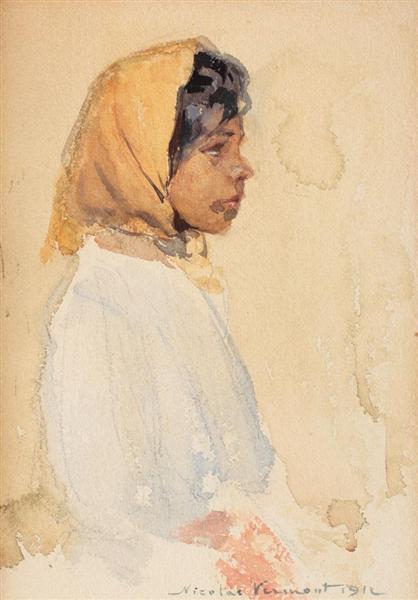Description
The work "Gypsy woman with yellow handkerchief" (1912) by Nicolae Vermont is part of an artistic context in which the human figure is approached introspectively and poetically. This portrait, which presents us with a gypsy woman, stands out not only for the painter's technical mastery, but also for the emotional wealth that emerges from the image. Vermont, a recognized artist of Romanian origin, is known for his ability to capture nuance and expression, elements that resonate throughout his career.
In the composition, the central figure of the gypsy occurs imposingly, almost as an icon. His face, framed by a yellow handkerchief that contrasts with the most bleak tones of the background, becomes the inevitable focus of the viewer. The choice of this vibrant color is not accidental; Yellow radiates a light that symbolizes both the warmth and the complexity of the gypsy culture, taking the observer to a sensory journey that evokes the mystery and nostalgia of this community often misunderstood.
The look of the woman, intense and deep, seems to tell a silent story, inviting contemplation. Nietzsche said that what is not expressed in words can be in the eyes. In this work, the expression of the gypsy, accompanied by a subtle game of lights and shadows, suggests a rich and complex narrative, evoking the experiences of a life full of history, tradition and suffering. His posa, erect and proud, reflects an inherent force that defies the external looks and the stereotyped perception that he often faces his ethnicity.
The use of color is a central aspect in Vermont's work. A carefully selected palette is observed where earthly tones coexist with vibrant accents. The background, of more turned off, allows the figure of the gypsy to highlight fully, creating a visual balance that emphasizes the idea of dignity and resistance. The texture of the woman's skin, treated with special care, highlights her humanity and beauty, while the handkerchief seems to have a life of her own, gently waving as if the wind caresses it, suggesting movement and vitality.
Nicolae Vermont, like other contemporaries of his, was part of a movement that valued the portrait as a form of psychological and social exploration. They share this approach artists such as Sorolla and Zorn, who also knew how to capture the light and essence of their subjects through their palette and technique. Vermont's work is a testimony of the ability of painting to go beyond simple representation; It is a means to explore cultural and emotional identities.
In conclusion, "Gypsy woman with yellow handkerchief" is a significant example of Nicolae Vermont's legacy, which combines technical, color and emotion in a deeply human representation. This work, with its vibrant touch of yellow, invites us to contemplate not only the beauty of the portrayed subject, but also the richness and complexity of the gypsy identity, a narrative that resonates over time, reminding us of the importance of seeing beyond The appearances to reach the essence of the human being.
KUADROS ©, a famous paint on your wall.
Hand-made oil painting reproductions, with the quality of professional artists and the distinctive seal of KUADROS ©.
Art reproduction service with satisfaction guarantee. If you are not completely satisfied with the replica of your painting, we refund your money 100%.

